RV Skirting Ideas. Many RV owners place their RVs away when the cold season of winter hits. This is because RVs are not designed specifically for dealing with challenging winter temperatures, so being comfortable during the cold months may be difficult when staying in an RV.
Unlikely, but not impossible, and as winter RVing can be just as enjoyable as camping in the summer, finding ways to ride out the cold weather in your travel trailer or motorhome may be worth a try.
Many individuals take into account putting up RV skirting when they need to prepare for RVing in winter. In this article, we’ll look at this option in detail, detailing the reasons why choosing it will likely benefit you. See our guide to wintering to learn all about RVing.
Table of Contents
What is skirting?

A protective tube is installed around an RV’s base to protect against winter temperature changes. Protecting the plumbing system leads to a comfortable RV cabin. It’s recommended for use during cold RV seasons. Insulation built into the vehicle is also useful in keeping the interior at ease. You can buy customized camper skirting if you’re interested in paying. In some cases, you can use prefabricated skirting kits as is, or you can invest more money into adding a customized touch. If you’d like to get a project done for yourself, you could build your trailer skirting.
Why should you use RV skirting?

If you permanently live in your RV or enjoy taking cold weather vacation trips and camping in regions where freezing temperatures are more common, periodically skirting your RV is a wise precaution. It involves a little work, but the result is that you have peace of mind that your plumbing system will withstand the cold temperatures while still allowing you access to running water.
Does an RV skirt work?

Let me give you an example. Rental property in North Carolina where it is rarely cold, but it can freeze. The property has a well to supply water to the house. The pump and tank for the well are effectively at ground level. On top of that, I built a wall with a roof around the pump and tank to guarantee it was protected from freezing temperatures. Then, you can add a light inside the refrigerator that can be turned on or off. Whenever freezing temperatures are in the forecast, turn on the light to provide heat in the enclosed space and prevent the storage and tank from freezing. It’s the same principle as skirting your RV. You cover the bottom of the refrigerator to stabilize it and grant access to heat to prevent freezing.
Types of RV Skirting Material
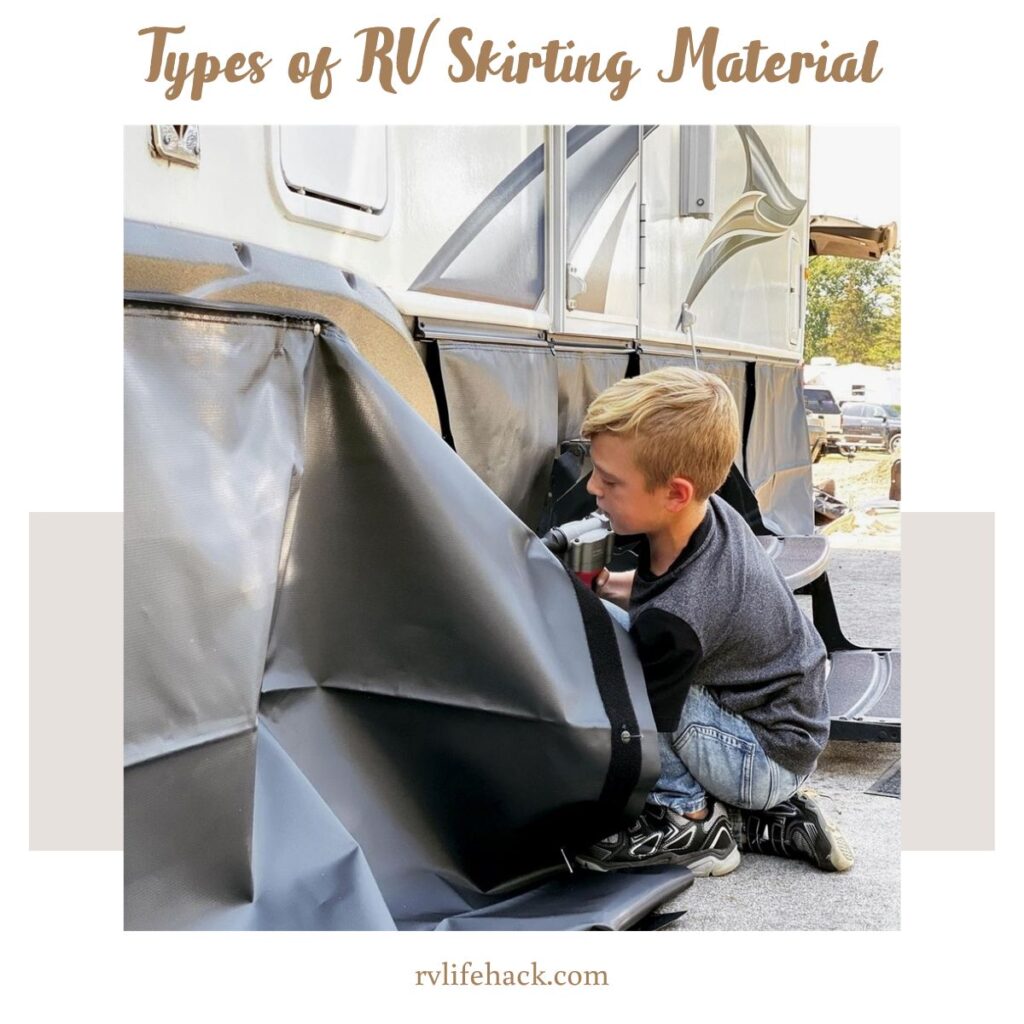
Skirts may be made from a broad range of materials. Here are some of the more commonplace ones:
Plywood RV Skirting
RV skirtings are made of wood and from wide, versatile varieties. Plywood skirting is the standard product, and it is very easy to purchase and adhesive. You will have to cut the material down into the desired shape and shape it prior to installation, though plywood skirting is an easy way to insulate outlying RVs and stationary trailers. We say stationary since you’ll have to detach the skirting and store it once you choose to move it, and because plywood is heavy and can get dirty and damaged over time, it’s not a viable option. The advantages of plywood skirting are that it can be used to store camping equipment and other toys underneath the RV.
Vinyl RV Skirting
It is very common to see RV skirtings made of fabric, but vinyl is the most common because it is inexpensive, easy to DIY, and can store a lot of gear. It is possible to adjust them to fit an RV, trailer, or fifth wheel. Individuals who specialize in making vinyl tiles make vinyl skirtings that are especially ornate and costly and take up a great deal of room. Heavier vinyl skirtings can also add to the overall weight of the RV.
Straw Bales
It stands to reason that if you have straw or hay bales close to your location, you can use them as linings for an RV parking place. All you need to do is stack the hay around the RV and finish. However, though hay and straw are flammable, mice and insects often nest within them, creating an unpleasant atmosphere.
Tarps
Like vinyl, the tarp is also an inexpensive product used to make your RV skirting materials. Tarps are simple to find, durable, and reusable. You can also purchase insulated tarps that are effective in RV temperature control. However, a boutique style of cutting and installing tarps takes time and special tools and is a relatively expensive and time-consuming process to consider investing in. Insulated tarps are costly and take up plenty of storage space like vinyl RV skirts.
Snow
Like hay bales, you can temporarily use blocks of snow to protect yourself from the cold underneath your RV. Just shovel some snow around your RV; the pile will hold up underneath your RV’s underbelly. A rigid foam skirting can also be used to make a small frost barrier around the edge of your RV. Keep in mind, however, that ambient temperature may cause the geofoam to melt over time, requiring you to replace it throughout the journey.
RV Skirting Cost
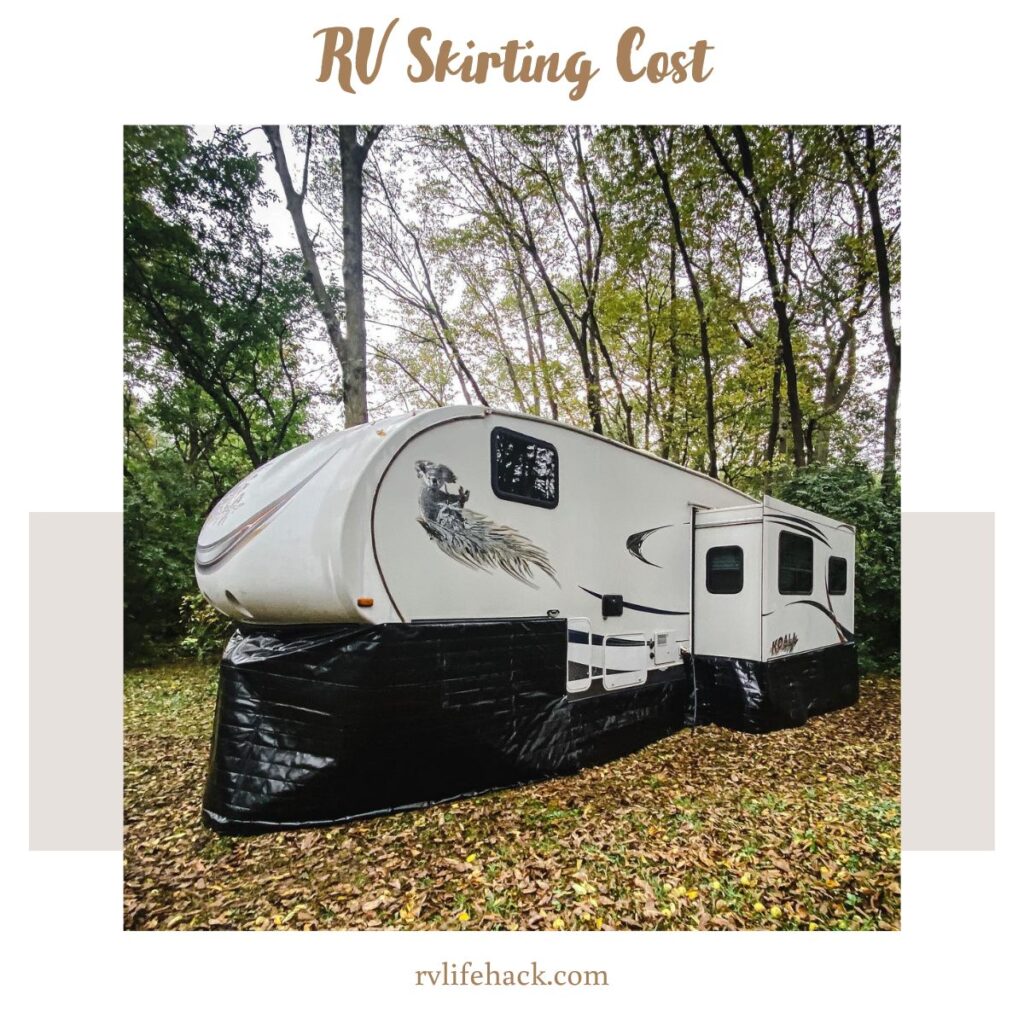
Are you curious about how much it pays to have your RV skirted? Off the rack, the price of a professional job typically ranges from a couple of hundred dollars to a thousand dollars. The most expensive option will be custom-made skirting, while pre-made kits will come in a close second. Choose from your array of both artistic and creative ideas depending on how pricey you’d like to go.
RV Skirting Solution
There are several ways in which RV skirting can be installed on your RV. Some of the most popular are listed here:
RV Airskirts

Airskirts are an innovative RV skirting solution. The skirting comes from inflatable tubes that the pump can inflate. As they inflate, the tubes form a snug fit around the contours of your RV, insulating it from the elements. AirSkirt kits are available in several sizes, with everything necessary to install. They are reusable and can be stored in your RV when not used. To learn more about their disadvantages, read up beforehand. AirSkirts can be expensive, and they take up a lot of storage.
RV Wind-Skirt

RV WindSkirt is a mobile canvas-based RV skirting that’s easy to install and is much cheaper than EZ Snap RV skirting. WindSkirt comes in two sizes but is customizable to fit most recreational vehicles. It’s made from the very top of the skirt connecting to the entire RV. Directly while the base is low to the ground, it creates a cozy seal between the RV’s bottom and base. Velcro straps attached to the panel of each skirt make it simple to attach and install as per your simple desire. Family wind stop is helpful when cold weather occurs as long as the weather doesn’t become windy.
EZ Snap RV Skirting

EZ Snap RV skirting offers a tailored fit without the high price tag. You can get EZ Snap RV Skirting kits in a range of sizes. When you receive your kit, you’ll have to cut the skirting and set it by yourself, but there are many tips available to help (as the name suggests, they are quick to snap RV skirting). The Diamond Weave exercise tabletop is a few tenths the traditional weight per square foot fiberglass tabletop. In inclement weather, the fifth wheel RV skirting is said to have a normal lifetime reaching approximately 6 to 8 years.
DIY RV Skirting

Of course, you can buy the materials needed for an RV skirting and install one yourself. If you decide upon RV skirting made of fabric, you can easily attach loops or adhesive strips to hold the panels to the RV. Rocks or stones beside the RV can restrain vinyl and canvas RV skirts. Plywood or foam board skirting can be created and attached to the RV using aluminum tape. You can also use hay bales or snow to shield the bottom of your RV.
Custom RV Skirting

An expert can make a custom RV skirt at your request. Vinyl is very commonly used to make RV skirts, and you can obtain the RV skirt in the size and layout of your choice. You will learn what you can fit around your RV with the skirting professionals. Many professionals look at your RV before making you customized skirting panels that will go well with the motor vehicle like a glove. But just like any professional service, custom RV skirting is expensive, so make sure your vehicle investment is worth it.
Pros and Cons of Custom RV Skirting
Pros custom RV skirting
1. Less damage to your RV
It’s very likely that affixing your skirt or snap rings to hang your skirt will cause damage to the design of your RV. You’d also prefer tailored skirting, giving you more leeway in executing your project.
2. The convenience
Skirting around RV fifth tire, at least a full weekend of work, and another full day at least in the spring to take it down and fold it. It would not have been viable if we had had to move or travel often.
3. The appearance
According to a custom RV skirt, it will take a lot of skill to make DIY skirting match the quality of custom-made skirting. Custom skirting enables you to choose a color that blends well with the chassis of your camper, and the skirting will not damage the fabric of the walls of your trailer. From my own practical experience, I can tell you that the work of measuring, cutting, and joining the vinyl into an arbitrary position can be complicated, and it is very easy to make mistakes that result in the need for patching. Utilizing the services of a professional can ensure a neater finish.
4. Environmentally friendly
RV skirting made from foam board insulation, plastic, or plywood often ends up being discarded at the end of the winter season, only to be repurchased the following year. Regularly changing your skirting only once results in less waste.
5. Can re-use it each other
RVing in cold climates is why so many motorhome owners regularly buy custom RV skirting. You who often travel in cold climates accrue high costs by paying additional money for new materials to develop your own skirting each year. Our goal was to streamline our spiral wrap, but by the end of the winter season, many of the grommets fell apart, so it was thrown out, and a new one had to be created. In the second year, we might have done it better, but in the third year, we had to use foam board skirting instead because of the rules and regulations of the venue we were staying at. Over three years, we spent about $600 on our skirting. Knowing this in the beginning, we may have spent just a little bit more on having it made to order.
Cons of custom RV skirting
1. The cost
The most expensive option when it involves skirting an RV is awning material.
2. Put it by yourself
Having your skirting skill tailored can save you several hours of effort, but you will still likely have to spend somewhere in the neighborhood of an hour or two putting it up each time you use the toilet. For some, the labor saved may not be enough to justify the extra cost.
3. Travel to the company location.
If you don’t have an RV skirting business near you, you may have to send your RV to where they are to buy it to get your camper determined and fitted for skirting. Some RV skirting companies authorize customers to pull on their land, while other companies will permit you to send your measurements and install skirting yourself.
4. Reduce the RV value
Certain skirting requires you to screw snaps or some other kind of hardware to your RV’s outside, which some RV retailers may consider negatively affecting your camper’s value. Not every professional skirting uses snaps, and many makeshift skirting solutions can also pose downsides for your RV’s outer appearance.
Best RV Skirting Ideas
Some ideas of RV skirting which can perfectly match your traveling experience in every weather and condition:
1. Vinyl RV Skirting
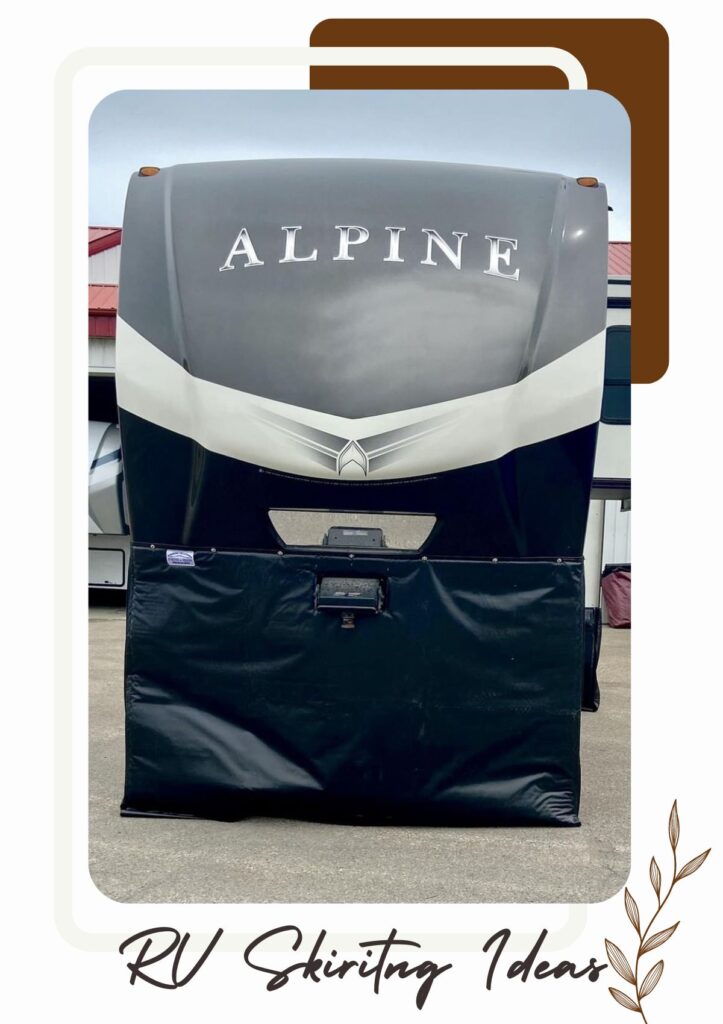
The most common skirting for recreational vehicles is vinyl. Vinyl became popular because it can perfectly warm your vehicle and keep it safe.
2. Custom RV Skirting

Trying to create a skirting like this is possible, so don’t be afraid to create it. But, you must focus on the tools and the material to make those skirting.
3. Snap RV Skirting

Having the pros and cons of RV skirting can’t be avoided. So, how to handle it? You must know very well what the skirting purposes are of your recreational vehicle.
4. DIY RV Skirting
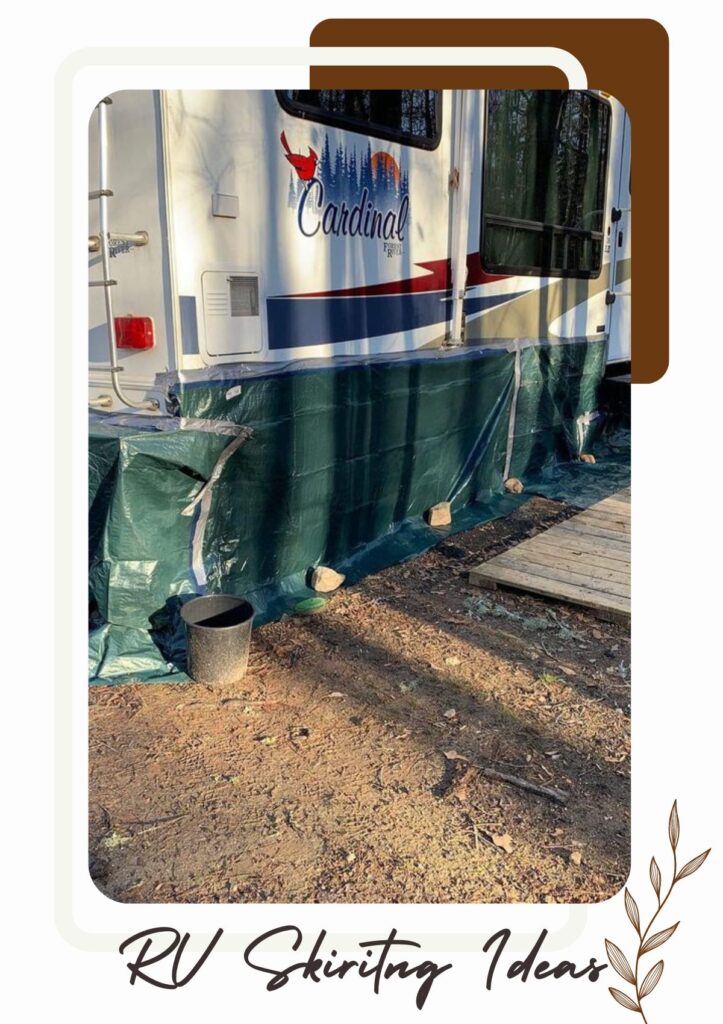
Using this idea will save you for a while. If you are not a full-time traveler, this skirting idea can be your best solution.
5. Fabric RV Skirting

The fabric also can be the solution for your RV skirting. The material has been very durable for a long time. Also, it is easy to store.
6. Full-time RVers

This skirting idea is made for the full-time traveler because the installation and the cost of this skirting are high.
7. Straw Bale RV Skirting
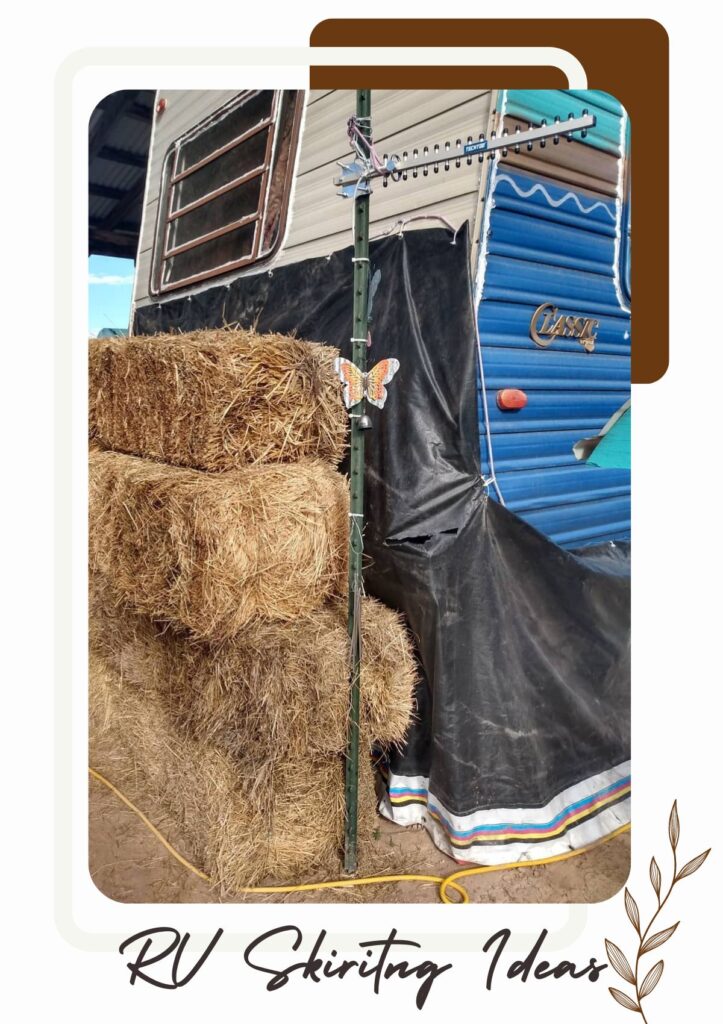
The straw bale RV skirting is temporary, and you can’t use it for a long time. But, the DIY straw bale idea is very clever and brilliant.
8. Best RV Skirting

Skirting your RV is very important because the cold condition will damage your RV badly. So, make sure you use the best RV skirting material and design.
9. Snow RV Skirting
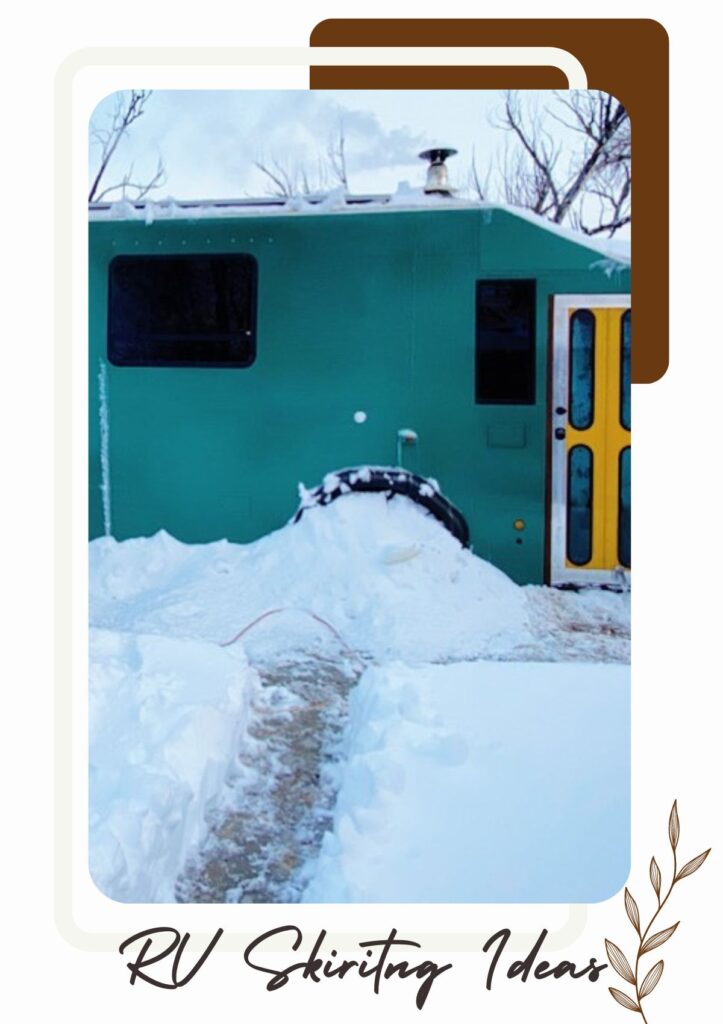
Worse conditions while traveling, use it as an advantage. Using the snow as the skirting for your RV is a smart choice.
10. Foam Board Skirting

One of the brilliant DIY skirting RVs, the foam board will keep your vehicle warm. Also, it will make you still warm too.
Conclusion
Insulating an RV skirting will prove fruitful for anyone using a vehicle in challenging weather conditions. It helps maintain a comfortable temperature and secures your water supply lines in colder climates. With RV skirting by AirSkirts, you can lower air conditioning costs and avoid vehicle damage. Because there are so many RV skirting options, we think this title should ultimately go to Armor Hitch Skirting. It installs in seconds and doesn’t require any special tools. Or you could try Insta-Klip for an alternative.

